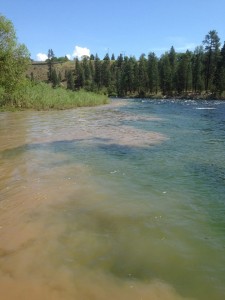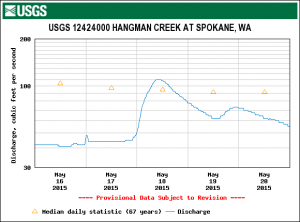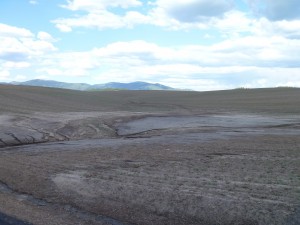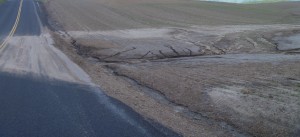The Spokane Riverkeeper received a flood of notifications last week recently regarding brown, dirty water in Hangman Creek. Hangman Creek frequently contains turbid, sediment laden water during heavy rains or rain on snow events that cause the creek levels to rise astronomically (in some cases over 1000 cfs in 30 minutes). What was unique about this pollution event was the lack of a dramatic rise in creek levels (see gage below). Although the creek bumped up about 90 cfs, this is a tiny blip compared to the increases of 3,000 to 7,000 cfs Hangman frequently experiences. So what explains the dirty water in the creek?
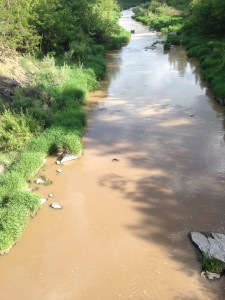
Poor farming practices, coupled with thunderstorms on 5/17/15, caused sediment laden dirt to flow from fallowed farmland directly into Hangman Creek and its tributaries.
A quick drive around the Hangman Creek watershed showed just how farming practices cause sediment to flow into our surface waters. Clear signs of erosion on fallow farmland, such as erosional rills, deeply incised channels, and evidence of dirt on the road were abundant throughout the Mica Creek drainage (see photos below). Fields farmed in this manner can lose up to 12-20 tons of soil an acre/year! (To put that in perspective a large dumptruck load of soil weighs about 8 tons). This erosion is preventable! Planting a cover crop could reduce the massive amounts of erosion occurring in this area of the Palouse. Erosion causes soil to be lost forever from this highly productive farmland while choking our surface waters.
Streamside vegetation effectively filters sediment from polluted farmland runoff. Unfortunately, riparian vegetation is sparse in the Hangman watershed, particularly on the intermittent streams that feed Hangman Creek. Without riparian buffers along all “waters of the state”, our surface waters will continue to be polluted.
Of course it takes rainfall to cause runoff and locally heavy precipitation delivered ample rainfall to wash sediment into Hangman Creek. Rain data from the Community Collaborative Rain, Hail, and Snow (CoCoRaHS) gages on 5/17/15 showed moderate rainfall accumulations of up to about 0.5” in Spokane and Whitman Counties. That probably isn’t enough to explain the dirt in Hangman Creek, even accounting for the terrible farming practices in the watershed. However, a comment from the CoCoRaHS station in Thornton, WA says:
“The big storm just skirted us last night. Unconfirmed reports of over 3.5" of rain east of Oakesdale, Wa, causing major damage”
If this storm hit unplanted fields that lack any riparian buffers, it would have caused the pollution we saw in Hangman Creek last week.
So what is the solution? In Washington State it is illegal to pollute our surface waters. If you see signs of erosion, such as erosional rills or sediment being carried to our surface waters, please report it to Ecology. In Spokane call (509) 329-3400 to report a potential pollution violation. Ecology is required to verify and act on these reports, so any reports you make go a long way to correcting pollution in Washington State.

